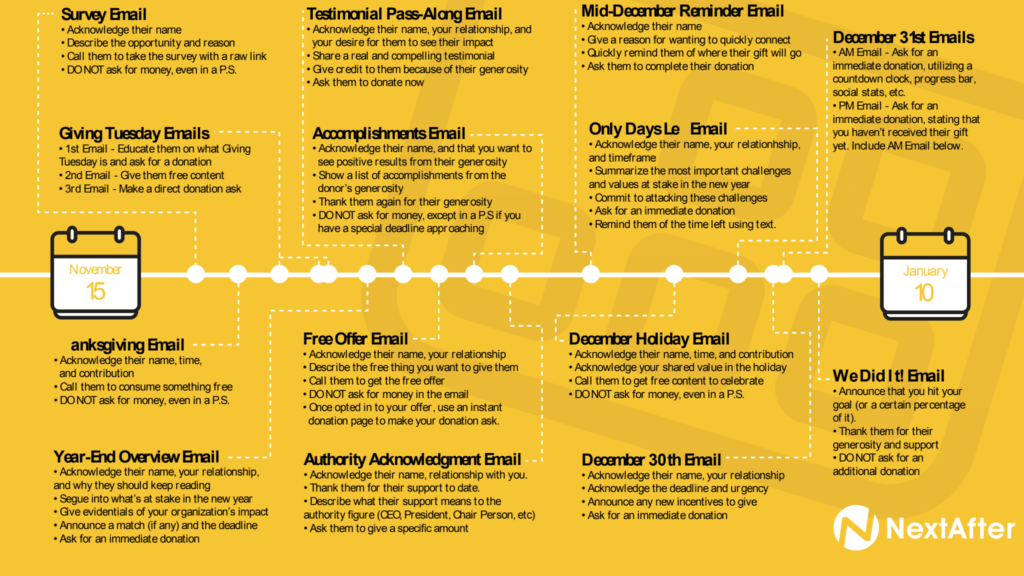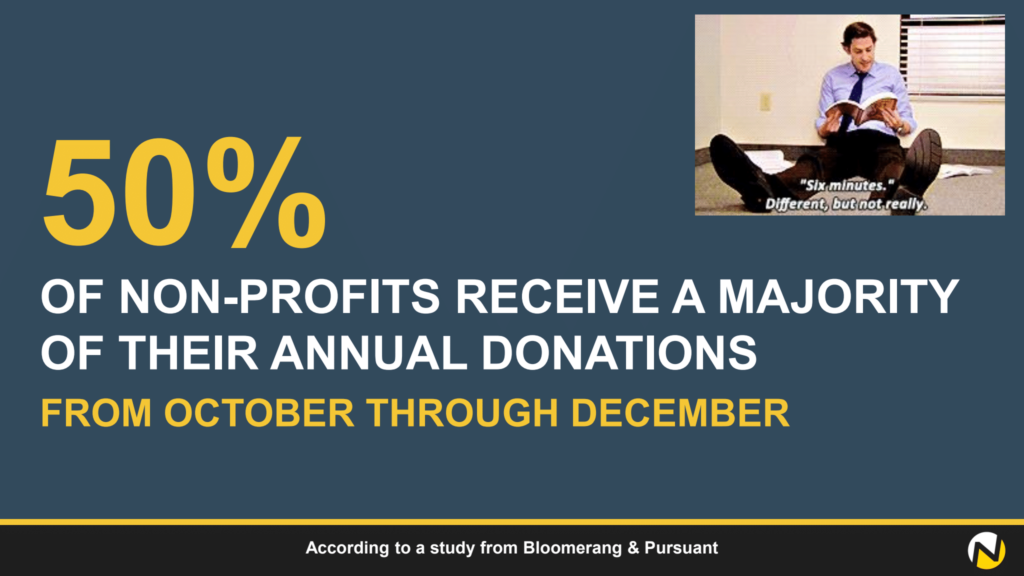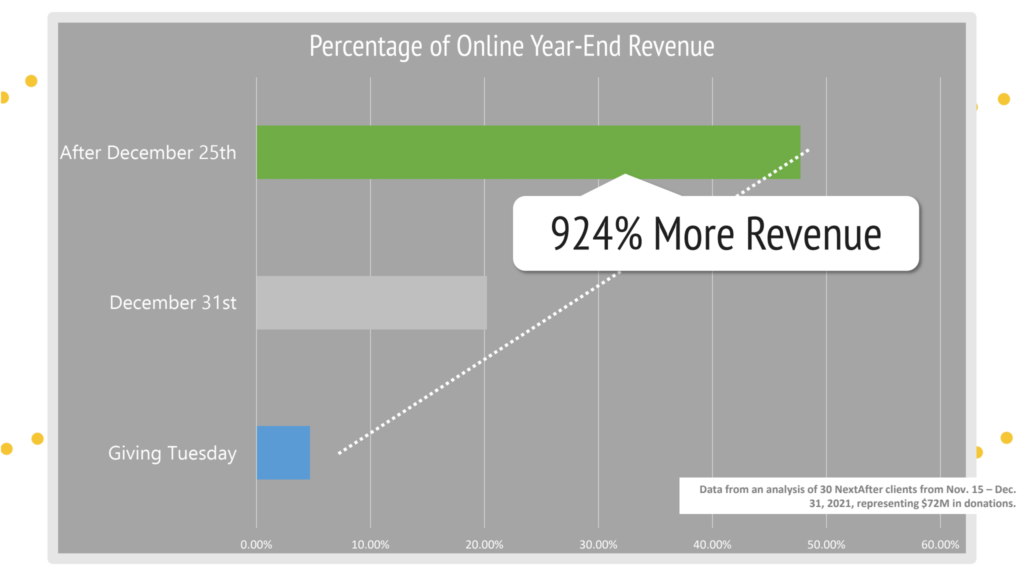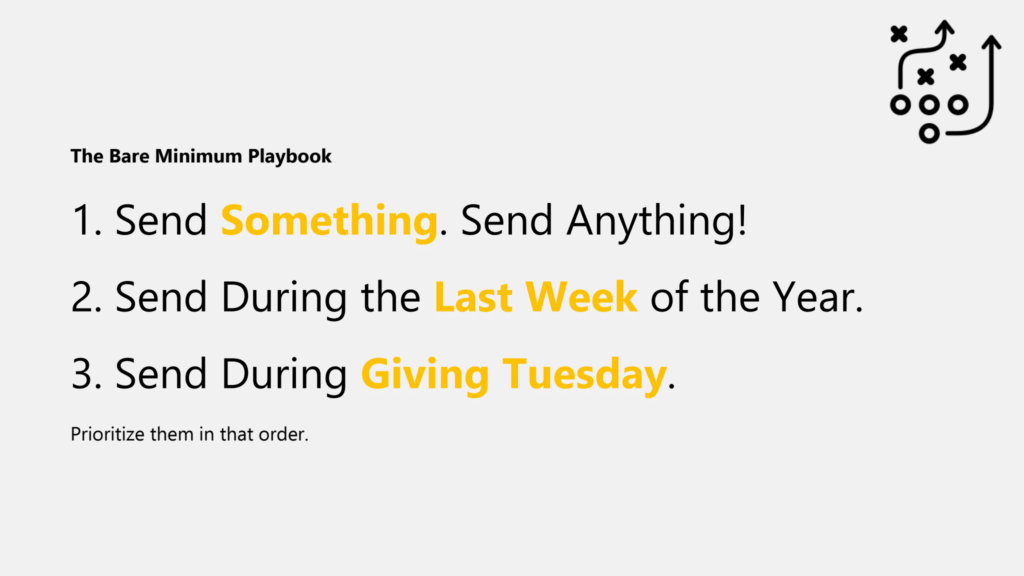Watch the Year-End Fundraising Playbook – Part 1
Welcome to the Year-End Fundraising Playbook. This is part one where we’re going to look at some benchmarking data around year-end and look at just how important the year-end fundraising season is for your whole program and then specifically for your online fundraising.
After this part, we’ll then dive into some specifics on different types of email communication that you can build into your email timeline during the year-end season to ensure that you have the best chance of raising the most money during this really critical season.
As I think about putting year-end fundraising training together, oftentimes I want to go reinvent the wheel. I think we have a tendency to want to do that in our programs too. Sometimes you get caught in the rut of doing the same thing year after year, whether it works or not, it’s like what you’ve done before, and so you want to go reinvent it. I felt the same way putting this training together.
When I’m trying to think about some sort of new epic analogy to make year-end fundraising cool or exciting again, I tend to focus on Star Wars, because I’m a huge Star Wars nerd. You can see on your screen, this is a picture of my iPad where I’m sketching out here’s what the whole Star Wars galaxy looks like.

You’ve got the core worlds, the inner rim, you’ve got the outer room, and you’ve got the unknown regions. All those little green dots, these might be donors that are in all these different places in the galaxy and we got to get them up to one single place, like back to the core, where they might give.
I was thinking we could talk about something like Sith Wayfinders and Jedi Wayfinders that are these tools that you can use to help someone find a force sensitive person, find the center, or find a single point in the galaxy without necessarily having a large star map and things like that. As I got into this, obviously that’s way too deep.
That’s going to resonate with maybe two people that ever watch this and most likely not with you. If you’re the one or two people that are like, “I know what all that stuff is and that sounds cool,” let’s talk. It sounds like we were in line there, but this is way too deep. It’s going to align with maybe a couple of people, but miss quite a lot of people who are trying to figure out, how do I grow year-end fundraising?
I think even in this, there’s a lesson for us as fundraisers. You and I, as people that are passionate about a cause, tend to get fixated on things that are particularly interesting and exciting for us.
As a fundraiser who’s giving a good portion of your career, at least at this point in time, in your life, you’re giving this portion of your career to a specific cause. There’s specific aspects that get you really excited, that you might tend to focus on in your copy and in your narrative as you’re talking about fundraising during this critical giving season.
However, the things that resonate with you aren’t necessarily what’s going to resonate with every single potential donor. In order to unpack our story and our value proposition over the course of the year-end season, we have to address the reasons why someone should give from a wide variety of different angles.
That doesn’t mean we need to be really vague and all encompassing in all of our communication, but we need to tell the story from a lot of different angles.
My good friend John Powell uses this analogy, I think it’s a good one, that crafting your year-end fundraising is like cutting a brilliant diamond. Because the most expensive and the most beautiful diamonds are not necessarily the biggest ones, they’re the ones that have the best cuts. For a diamond to be most brilliant and beautiful and reflective, you have to have all these different angles and facets and cuts that reflect the light towards the center so it shines most brilliantly.
We want to do the same thing in our year-end fundraising campaigns. We have this tool that we use internally and we share it publicly for training purposes and things like that too. That’s the year-end fundraising email timeline.
On this timeline, there are actually 17 different types of emails that you can pick and choose from to build out your year-end campaign. Now, not everyone is ready to go send 17 different emails over the course of this 45 day year-end season from November 15th through the end of the year. You might be at a place where you’re just starting out. Maybe you’ve never run a focused and intentional year-end campaign before.

You might be looking at using four to five different emails over the course of the season. Maybe you’re a little bit more sophisticated to that. You’re trying to up your game. You’re using more like seven or eight or nine emails. Maybe you are ready for all 17. You’ve got lots of different segments that you’re talking to. You’ve got a sophisticated email fundraising program.
This timeline is meant to be a tool for you to pick and choose what’s right for your organization and give you different examples of communication that you can build into your timeline. You’re not just saying the same thing over and over, but you’re addressing the reasons why someone should give from a variety of angles throughout the season.
Now, the reason you’re here is because you care about year-end fundraising and you think it’s important. We won’t spend too much time here because you already think it’s important. That’s why you’re joining this training, but I do want to spend a few minutes talking about why you should care about year-end fundraising so much, because it’s a really critical point in your fundraising program and in the calendar year in terms of revenue opportunity.
Now, before we dive into those benchmarks, just a few words about NextAfter and what we do. We really do one primary thing, which is we help nonprofits grow their digital fundraising.
We do that in three ways:
- We’re a research lab, where we’re going out into the nonprofit marketplace and we’re trying to understand what are nonprofits actually doing to try to raise more money. However, looking at what nonprofits are doing doesn’t actually tell us what works. We have to take the best ideas that we discover through research and put them to the test using A/B testing, experimentation, and optimization. We do this through our digital first agency, where we work with about 45 different nonprofit organizations implementing digital strategies all driven by testing and optimization, because we want to decode what actually works to grow giving.
- Everything that we learn through the research lab and through our agency work and through experimentation and testing, we then turn into things like webinars, courses, tools, e-books, and all sorts of different training through our institute, because we don’t want take what we’re learning and just kind of hold it dear to ourselves. We want to go release it out into the marketplace, because ultimately we want to see giving and generosity grow. We want to equip you and as many nonprofits as we possibly can with what we’re actually decoding works to grow giving so we can all be more effective and unleash greater generosity.
- We conducted a study a couple of years ago around year-end fundraising, and we continue to monitor different benchmarks around year-end. But in the study that we conducted with Virtuous, we wanted to go understand how nonprofits are using multichannel fundraising in their communications. We looked at a normal giving period during the year, non year-end, and then we look specifically at year-end to see if there differences, are there similarities, and what are the trends back and forth? But one of the first things we had to look at is how much revenue actually comes in during this season.
Back in 2020 as we’re looking at the organizations we work with, we found 35% of online revenue for the year comes in during this 45 day window. There’s quite a lot of revenue. Fast forward to 2021, we saw organizations raising as much as 45% of their online revenue during the year-end season.
Now, you may say this is a small sample size or these are organizations that are already fairly sophisticated. Is that really representative for me?
We’ve gone and we’ve looked at some other benchmarks as well. Our friends at Neon One have found that a third of annual giving occurs in the month of December, which is essentially saying the same thing. Slightly different timeframe, slightly different number, but it’s essentially saying the same thing. Our friends at Pursuant and Bloomerang have found that 50% of nonprofits receive a majority of their donations, their annual donations, in the fourth quarter, which again is different, but it’s not really different.
These are all saying the same thing, which is that there is a tremendous amount of revenue potential during the year-end season. You probably know this, which is why you’re here, but I just want you to see these numbers so that clearly how much is at stake.

The next part of this study was not just to look at how much is at stake, but how often are organizations communicating and what are they doing during this season to try to raise more funds?
What we found was that 37% of nonprofits actually sent nothing during this season to their postal donors. In this study, we had become an offline donor or a direct mail donor to these organizations, and then we waited to see what would they send us during year-end, and 37% sent us nothing.
Now, we had another persona, which was an online donor. We gave a gift through an online giving form and 13% of those organizations sent our online donor nothing during the year-end season. If we expect to see tremendous revenue coming in like these benchmarks tell us, we actually have to show up and we have to participate. We have to come to the table to play and be present with our donors. Because if you’re not talking to your donors during this season, I can guarantee you that there are so many other organizations that are.
If you’re not top of mind, you’re not present, and I’m looking to give, why would I give to you if you’re not even there? There’s all these other organizations with great causes where I can make a tremendous impact that are looking for my donation as well.
We have to come to the table and be present with our donors during this season. Now, there’s a common misconception and I think maybe some of this is changing. We’ve kind of been saying this year after year, but it’s still a misconception for some when we think about year-end fundraising.
There’s a lot of hype around GivingTuesday. It’s nearly impossible to miss GivingTuesday at this point, there’s so much social media interaction. I haven’t seen a recent benchmark on it, but a couple of years ago, they said there was 20 billion social media impressions about GivingTuesday on GivingTuesday.
If you have a phone and you exist on planet earth, you’re going to see something about GivingTuesday this year and for years to come. There’s a lot of hype around it; however, we have to keep everything in the right priority.
GivingTuesday brings in about 4% of online revenue for the year-end season in one day, which is really significant. It’s a lot of revenue, so don’t get me wrong there. It’s an important day that you should be present for and you should have a plan around, but it’s not everything. When we compare it to the last day of the year, December 31st brings in 20% of online revenue for the year-end season.
Zoom out to the full last week of the year, the last week of the year brings in about 47% of online revenue for the year-end season. Now, we’d like to look at conversion rates, percent lift, percent decrease, and that sort of stuff. December 31st, 334% more revenue at stake than on GivingTuesday. Last week of the year, 924% more revenue at stake.
Again, I’m not here to say that you shouldn’t care about GivingTuesday. I’m saying we need to get our plans in the right priority, understanding how much revenue is at stake at these key points in the season.

Here’s what’s really interesting, as we’re conducting this type of analysis and research to figure out what nonprofits are doing; we found that 20% of organizations sent mail during the week of GivingTuesday. Not just the day, but looking at the full week.
Also, 57% of organizations sent an email during the week of GivingTuesday. Quite a lot of organizations aren’t participating in the first place, but these are the ones that are. Keep these numbers in mind.
We’re going to look at how many organizations participated during the last week of the year. The numbers aren’t that different 18% are sending mail and 58% are sending email.
As we’re looking at the volume of communications that are coming in, what we’ve found is that there’s really minimal difference in how nonprofits treat GivingTuesday versus the last week of the year. Despite the disparity between the amount of revenue that’s at stake between those two different giving days/weeks as we just looked at. This is not all that sophisticated and it’s probably not going to blow your mind, but we’ve got to make sure that we do the basics first.
The bare minimum Year-End Fundraising Playbook for you, plan to send something:

If you haven’t planned to send anything yet, plan to send something. Send at least an email. If you can get something in the mail, even as simple as a postcard, that’d be wonderful. Send something to your donors. Again, if you don’t, someone else absolutely will.
Number two, make a plan to be present during the last week of the year and focus most of your efforts on figuring out what is the right plan to make sure that you capitalize on this last week when there’s so much revenue at stake.
Then third, send something during GivingTuesday. Obviously GivingTuesday comes first in the calendar, but that doesn’t mean that we should put all of our focus on it. Make sure you have a plan for it, but make sure you prioritize the last week of the year in your planning.
Again, prioritize all three of these things in this order.
Now, coming up in the next lesson, we’re going to dive a little bit deeper into some of the specific strategies. We’re going to start looking at the first of three different categories of communication that you can build into your email timeline to make sure that before you ask for money, you’re actually cultivating the relationship. That’s coming up next.
Watch Year-End Fundraising Playbook Webinar- Part 2 »

Additional Resources
Year-End Fundraising for Online Fundraisers
Discover new ideas to craft a successful year-end fundraising campaign for your organization based on years of research and thousands of fundraising experiments
Activate your free course hereBe the First to Know About Upcoming Events
Make sure you don’t miss the next online fundraising webinar – packed with data-driven insights, tactics, and strategies from our library of 5000+ online fundraising experiments.
Where should we send your notification about the next webinar?



